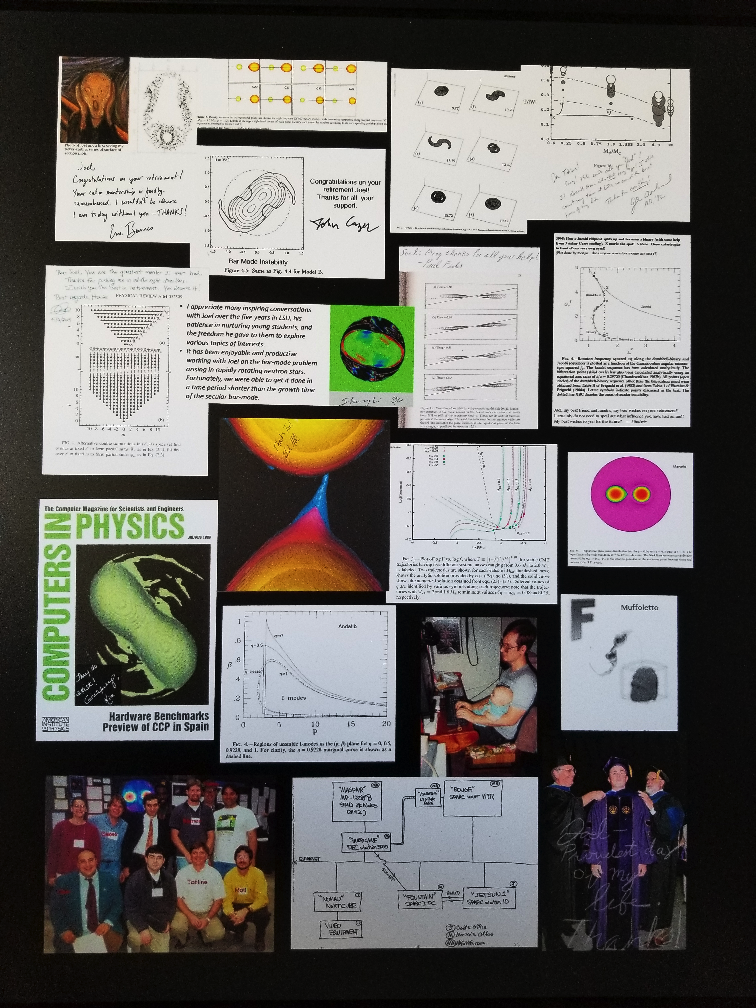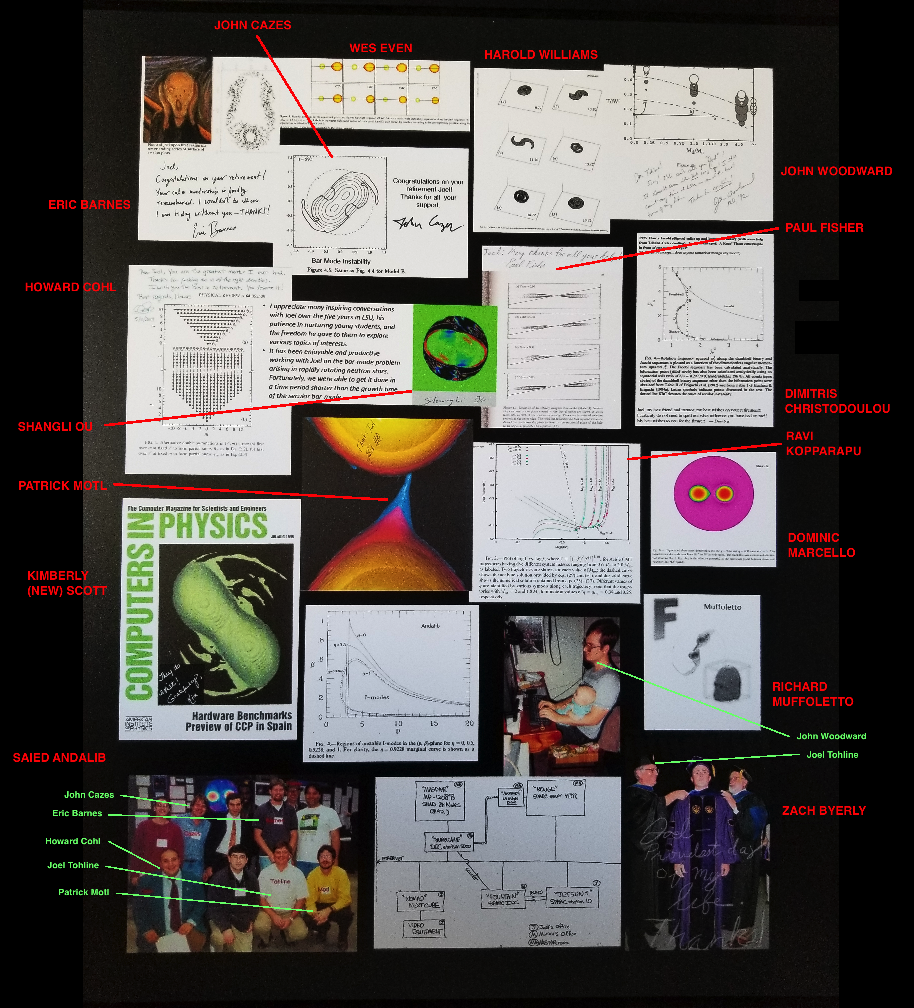Difference between revisions of "User:Tohline/Appendix/Ramblings/MyDoctoralStudents"
| Line 172: | Line 172: | ||
<td align="right">1976 - 1978</td> | <td align="right">1976 - 1978</td> | ||
<td align="left"> | <td align="left"> | ||
Tohline's dissertation research under the guidance of Peter Bodenheimer (UCSC) and David Black (NASA/Ames) was an early attempt to examine whether of not isothermal gas clouds whose mass exceeds the Jeans mass spontaneously fragment during a phase of free-fall collapse. The adopted Eulerian computational hydrodynamics scheme was first-order donor-cell based on the 2D (axisymmetric, cylindrical-coordinate) scheme described by Black & Bodenheimer (1976) but extended by Tohline to a 3D grid; a typical simulation was carried out on the CDC7600 at NASA/Ames and involved <math>~30^3 \approx 3 \times 10^4</math> grid cells. The self-consistently determined, time-dependent ''Newtonian'' gravitational potential was determined by combining (1) an FFT technique in the azimuthal coordinate direction, with (2) a Buneman Cyclic Reduction technique in R and Z. | <font color="red">Tohline's dissertation research</font> under the guidance of Peter Bodenheimer (UCSC) and David Black (NASA/Ames) was an early attempt to examine whether of not isothermal gas clouds whose mass exceeds the Jeans mass spontaneously fragment during a phase of free-fall collapse. The adopted Eulerian computational hydrodynamics scheme was first-order donor-cell based on the 2D (axisymmetric, cylindrical-coordinate) scheme described by Black & Bodenheimer (1976) but extended by Tohline to a 3D grid; a typical simulation was carried out on the CDC7600 at NASA/Ames and involved <math>~30^3 \approx 3 \times 10^4</math> grid cells. The self-consistently determined, time-dependent ''Newtonian'' gravitational potential was determined by combining (1) an FFT technique in the azimuthal coordinate direction, with (2) a Buneman Cyclic Reduction technique in R and Z. | ||
<font color="red">Richard Durisen</font> — a NASA/Ames postdoc at the time — said to me something along the lines of, "Hey! When you finish developing that hydrocode, let's get together and examine the dynamical stability of rapidly rotating, equilibrium configurations." | |||
</td> | </td> | ||
<td align="center">''sf''</td> | <td align="center">''sf''</td> | ||
<td align="center"><font size="+2" color="darkblue">♦</font></td> | |||
<td align="center">--</td> | |||
<td align="center">--</td> | |||
<td align="center">TBD</td> | |||
</tr> | |||
<tr> | |||
<td align="right">1978 - 1982</td> | |||
<td align="left"> | |||
While at Yale University (1978 - 1980) and at Los Alamos National Laboratory (1980 - 1982), Tohline worked closely with Richard Durisen (Indiana University) to examine the onset and nonlinear development of nonaxisymmetric instabilities in differentially rotating, n = 3/2 polytropes whose internal angular momentum distribution was that of an n' = 0 sequence. Generally speaking, unstable eigenfrequencies matched earlier predictions (by other groups) based on linear stability analyses; unstable eigenfunctions displayed a two-armed spiral character. As the amplitude of unstable modes grew to nonlinear amplitude, the developed spiral arms were able to effectively redistribution angular momentum, preventing fragmentation/fission of the configurations. | |||
<font color="red">Nelson Caldwell</font> — a Yale graduate student at the time — showed Tohline some of his early work focused on the observationally determined properties of elliptical galaxies that display prominent dust lanes. Additional discussions led to a collaboration between Caldwell, Tohline, and <font color="red">Gregory Simonson</font> — also a Yale graduate student at the time — in which the observed orientation of dust lanes can be explained in terms of dissipative settling of gas disks and, as a consequence, can be used to deduce the underlying geometry (e.g., oblate or prolate spheroidal) of each galaxy's mass distribution. With guidance from Tohline, Simonson completed a Yale University doctoral dissertation in which this settling model was extended to the context of polar rings in spiral galaxies. | |||
</td> | |||
<td align="center">''sf, gd''</td> | |||
<td align="center">--</td> | <td align="center">--</td> | ||
<td align="center">--</td> | <td align="center">--</td> | ||
<td align="center">--</td> | <td align="center">--</td> | ||
<td align="center"> | <td align="center">TBD</td> | ||
</tr> | </tr> | ||
<tr> | <tr> | ||
<td align="left" colspan="7"><sup>‡</sup>Research areas in which significant contributions were made: Astrophysics (A), Computational Hydrodynamics (CH), Visualization (V), and Other (O). Subcategories under Astrophysics are ''sf'' (star formation), ''gd'' (galaxy dynamics), GR (sources of gravitational radiation). | <td align="left" colspan="7"><sup>‡</sup>Research areas in which significant contributions were made: Astrophysics (A), Computational Hydrodynamics (CH), Visualization (V), and Other (O). Subcategories under Astrophysics are ''sf'' (star formation), ''gd'' (galaxy dynamics), GR (sources of gravitational radiation). | ||
Revision as of 23:37, 26 May 2019
Chronology of Research Endeavors

|
|---|
| | Tiled Menu | Tables of Content | Banner Video | Tohline Home Page | |
Doctoral Students Tohline Has Advised
| Doctoral Students Whom Tohline has Advised at LSU | |||||||
|---|---|---|---|---|---|---|---|
| Year of Ph.D. | Student Name | ED† | Jointly Advised? |  |
|||
| 1988 | Harold Williams | ||||||
| 1989 | Dimitris M. Christodoulou | ||||||
| 1992 | John Woodward | ||||||
| 1994 | Horst Väth | w/ Detlev Koester (Univ. of Kiel, Germany) | |||||
| 1996 | Kimberly C. (Barker) New | ||||||
| 1998 | Paul Fisher | ||||||
| 1998 | Saied Andalib | ||||||
| 1998 | Erik Young | w/ Ganesh Chanmugam (LSU Physics & Astronomy) | |||||
| 1999 | John E. Cazes | ||||||
| 1999 | Howard S. Cohl | ||||||
| 2001 | Eric I. Barnes | ||||||
| 2001 | Patrick M. Motl | <math>~\odot</math> | w/ Juhan Frank (LSU Physics & Astronomy) | ||||
| 2004 | Shangli Ou | <math>~\odot</math> | |||||
| 2006 | Ravi Kumar Kopparapu | <math>~\odot</math> | |||||
| 2006 | Richard P. Muffoletto | <math>~\odot</math> | w/ John Tyler (LSU Computer Science) | ||||
| 2010 | Wes P. Even | <math>~\odot</math> | |||||
| 2010 | Jay M. Call | <math>~\odot</math> | |||||
| 2011 | Dominic C. Marcello | <math>~\odot</math> | |||||
| 2014 | Zachary D. Byerly | <math>~\odot</math> | |||||
|
|||||||
Outline of Research Activities
| Years (approx.) | Comments | Significant Research Contributions‡ | Discussion | |||
|---|---|---|---|---|---|---|
| A | CH | V | O | |||
| 1976 - 1978 |
Tohline's dissertation research under the guidance of Peter Bodenheimer (UCSC) and David Black (NASA/Ames) was an early attempt to examine whether of not isothermal gas clouds whose mass exceeds the Jeans mass spontaneously fragment during a phase of free-fall collapse. The adopted Eulerian computational hydrodynamics scheme was first-order donor-cell based on the 2D (axisymmetric, cylindrical-coordinate) scheme described by Black & Bodenheimer (1976) but extended by Tohline to a 3D grid; a typical simulation was carried out on the CDC7600 at NASA/Ames and involved <math>~30^3 \approx 3 \times 10^4</math> grid cells. The self-consistently determined, time-dependent Newtonian gravitational potential was determined by combining (1) an FFT technique in the azimuthal coordinate direction, with (2) a Buneman Cyclic Reduction technique in R and Z. Richard Durisen — a NASA/Ames postdoc at the time — said to me something along the lines of, "Hey! When you finish developing that hydrocode, let's get together and examine the dynamical stability of rapidly rotating, equilibrium configurations." |
sf | ♦ | -- | -- | TBD |
| 1978 - 1982 |
While at Yale University (1978 - 1980) and at Los Alamos National Laboratory (1980 - 1982), Tohline worked closely with Richard Durisen (Indiana University) to examine the onset and nonlinear development of nonaxisymmetric instabilities in differentially rotating, n = 3/2 polytropes whose internal angular momentum distribution was that of an n' = 0 sequence. Generally speaking, unstable eigenfrequencies matched earlier predictions (by other groups) based on linear stability analyses; unstable eigenfunctions displayed a two-armed spiral character. As the amplitude of unstable modes grew to nonlinear amplitude, the developed spiral arms were able to effectively redistribution angular momentum, preventing fragmentation/fission of the configurations. Nelson Caldwell — a Yale graduate student at the time — showed Tohline some of his early work focused on the observationally determined properties of elliptical galaxies that display prominent dust lanes. Additional discussions led to a collaboration between Caldwell, Tohline, and Gregory Simonson — also a Yale graduate student at the time — in which the observed orientation of dust lanes can be explained in terms of dissipative settling of gas disks and, as a consequence, can be used to deduce the underlying geometry (e.g., oblate or prolate spheroidal) of each galaxy's mass distribution. With guidance from Tohline, Simonson completed a Yale University doctoral dissertation in which this settling model was extended to the context of polar rings in spiral galaxies. |
sf, gd | -- | -- | -- | TBD |
| ‡Research areas in which significant contributions were made: Astrophysics (A), Computational Hydrodynamics (CH), Visualization (V), and Other (O). Subcategories under Astrophysics are sf (star formation), gd (galaxy dynamics), GR (sources of gravitational radiation). | ||||||

|
|---|
|
© 2014 - 2021 by Joel E. Tohline |
